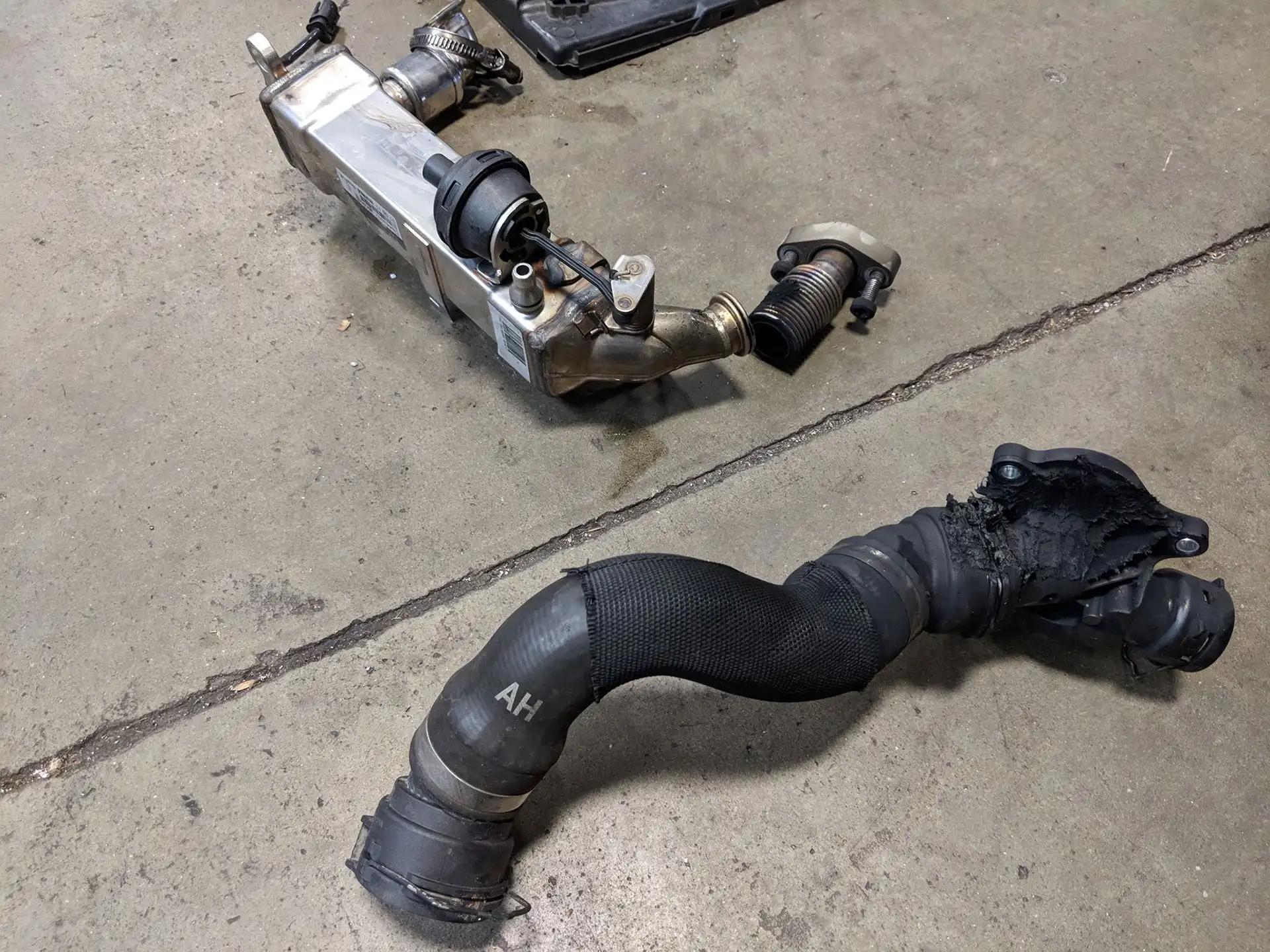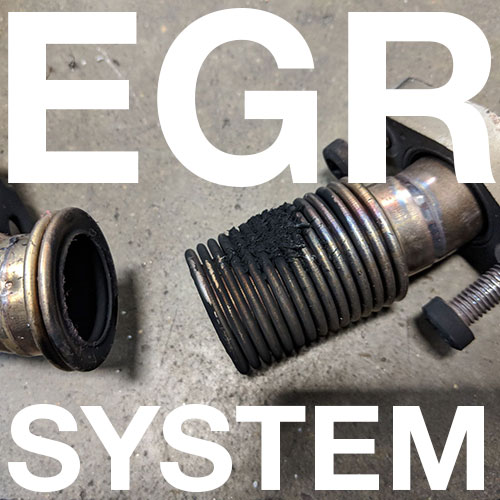When it comes to listing off the least glamorous systems underneath your hood, EGR would most likely be at the top of your list. Standing for Exhaust Gas Re-circulation, this system takes some of the exhaust out of the exhaust manifold and re-routes it back up into the intake to be re-digested by the engine. The purpose of this is to reduce the amount of noxious gas (NOx to be exact) emissions. NOx forms in a specific range of heat and pressure during the combustion process, and by routing exhaust into the oxygen stream, it effectively dilutes the O2 mixture with inert, already burned gas. With less oxygen, your engine burns a little cleaner and a little cooler. This is not to be confused with secondary air injection (SAI) which takes fresh air and pumps it into the exhaust to improve emissions.
How the EGR System Works
 The EGR system is different on most cars, but most play by the same principle. The exhaust manifold has a pipe coming off of it that goes to the EGR valve, the key component in all of this. A small electronic valve controls the vacuum signal going to this valve via ECU, just like a turbo wastegate. When the engine is revving to the point where the temps and pressures are suitable for producing harmful NOx, the computer signals the solenoid to divert vacuum to the EGR valve, it opens, and exhaust is sent into the intake, thus cooling the cylinders and making your engine run a little more efficient. Older systems will lack the computer controlled element and base the EGR function primarily on vacuum signal.
The EGR system is different on most cars, but most play by the same principle. The exhaust manifold has a pipe coming off of it that goes to the EGR valve, the key component in all of this. A small electronic valve controls the vacuum signal going to this valve via ECU, just like a turbo wastegate. When the engine is revving to the point where the temps and pressures are suitable for producing harmful NOx, the computer signals the solenoid to divert vacuum to the EGR valve, it opens, and exhaust is sent into the intake, thus cooling the cylinders and making your engine run a little more efficient. Older systems will lack the computer controlled element and base the EGR function primarily on vacuum signal.
Some cars utilize an electronic solenoid style EGR valve, which deletes the vacuum system out of the equation. Some cars also incorporate other devices in-line, such as EGR coolers so that hot exhaust isn’t going straight into the intake.
The EGR system takes a lot of heat abuse.
While the exhaust manifolds are made of dense, heavy cast iron or steel to help absorb heat, the EGR parts that make it up are much smaller and thinner. With a few thousand heat cycles, some of the joints can become brittle and break. That is perfectly illustrated in this BMW X5 part.

Now, the Diesel X5 has had a number of recalls relating to the EGR system, but as far as I know this is not related to any of those problems. This small flex pipe moves as the engine torques, and with the heat cycling, as well as some small weakness in the metal, the EGR Cooler depicted above broke apart and began blowing hot exhaust gasses onto a plastic coolant flange, ultimately melting it. Not all cars have an EGR cooler, but many incorporate small EGR flex pipes that need to be looked at every so often for signs of leaks (such as carbon build up).
The EGR System is prone to carbon buildup.
 Like mentioned above, EGR parts are much smaller than the exhaust manifolds, and funneling exhaust gasses through them is often fairly constrictive. Compounding that, the period when the EGR valve is open and funneling exhaust into the combustion is during high carbon emissions (heavy engine load). When idling or cruising, the EGR Valve usually stays shut, or partially closed. EGR failures often are the result of these passageways getting clogged up, which will result in a check engine light.
Like mentioned above, EGR parts are much smaller than the exhaust manifolds, and funneling exhaust gasses through them is often fairly constrictive. Compounding that, the period when the EGR valve is open and funneling exhaust into the combustion is during high carbon emissions (heavy engine load). When idling or cruising, the EGR Valve usually stays shut, or partially closed. EGR failures often are the result of these passageways getting clogged up, which will result in a check engine light.
Sometimes to remedy a check engine light caused by a clogged EGR, all you need to do is clean all the built up carbon out with some kind of super poisonous solvent. When doing this, be very careful to not get any in the actual workings of the EGR valve, such as the diaphragm or solenoid. Oh, don’t get any on yourself as well, wear gloves and glasses.
There’s a few things that can go wrong
When something goes wrong in the EGR system, you’ll get a check engine light between P0800 and P0808. Generally, you won’t notice your car running too bad, unless something is majorly wrong. In some instances a failure can open up a large enough vacuum or intake air leak to cause your engine to stumble. If you have a CEL and return one of these numbers, here are the most common culprits for these generic codes:
EGR System Related DTC’s
P0400 EGR Flow Malfunction – This is the most basic version of the EGR related check engine light, and could be a wide range of things. Remove the EGR valve and EGR pipe and check for carbon buildup clogging. Also check the operation of the valve if you are able to do so, and make sure it holds vacuum. If it’s electronic, you can test its operation with a 12v power supply. Lastly, make sure all the vacuum hoses and fittings connected are in good shape. If all good, it may simply be a sensor malfunction.
P0401 EGR Flow Insufficient Detected – The EGR pressure sensor is detecting low flow. This would most likely be cause by an EGR part that’s clogged up with carbon, whether it be an EGR pipe, EGR cooler (in the case of the X5 above) or valve. It can also be caused by low vacuum pressure due to a vacuum leak in the diaphragm or in a hose connected to it, causing the spring in the diaphragm to hold the valve closed. One last thing, there are a number of gaskets that could potentially leak. Look for leaking flanges and fix them quickly to avoid accidentally catching something on fire.
P0402 EGR Flow Excessive Detected – The EGR pressure sensor is detecting too much exhaust gas going into the intake. This is commonly caused by the valve being stuck open because its completely jammed with carbon crud.
P0403 EGR Circuit Malfunction – This is almost always caused by a bad EGR control solenoid, as the ECU isn’t reading the correct voltage off the electronic portion, signalling a short or an open circuit.
P0404 EGR Position Sensor Circuit Range/Performance – In some cases, the EGR valve has a position sensor on it that monitors the movement of the actuator, whether it be vacuum powered or actuated by a solenoid. When the ECU gets a reading from this sensor that is inconsistent with the command given to the control solenoid, it will throw this CEL. Most likely it is the EGR valve getting stuck or binding, or the control solenoid not accurately actuating the vacuum diaphragm.
P0405 EGR Sensor A Circuit Low – This is triggered when an EGR sensor is faulty and the ECU is not getting voltage to or from the sensor due to a short or an open connection.
P0406 EGR Sensor A Circuit High – This is triggered when an EGR sensor is faulty and the ECU is returning too much voltage to or from the sensor for some reason.
P0407 EGR Sensor B Circuit Low – This is triggered when an EGR sensor is faulty and the ECU is not getting voltage to or from the sensor due to a short or an open connection.
P0408 EGR Sensor B Circuit High – This is triggered when an EGR sensor is faulty and the ECU is returning too much voltage to or from the sensor for some reason.


